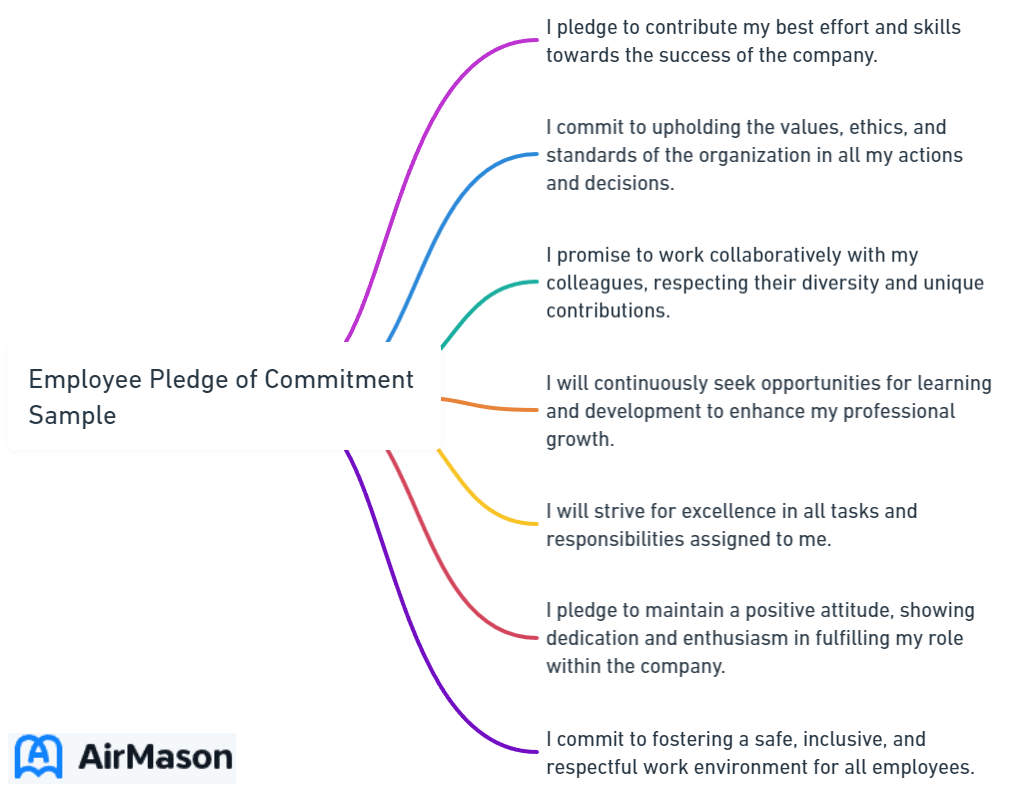
An employee pledge of commitment is a written statement that outlines an employee’s commitment to the organization’s values, goals, and expectations. It serves as a written agreement between the employee and the company, establishing a mutual understanding of responsibilities and fostering a positive work environment. This article explores the importance of an employee pledge of commitment and its components, along with a sample to provide a better understanding.
An employee pledge of commitment holds significant importance for both the employee and the organization. Firstly, it establishes a sense of belonging and alignment with the organization’s mission, vision, and values. This creates a cohesive and united workforce that works towards common goals. Secondly, it promotes organizational values and culture by reinforcing the expected behaviors and attitudes among employees. This aligns employees’ actions with the company’s objectives, resulting in a positive and productive work environment. Thirdly, an employee pledge of commitment enhances employee engagement by providing clarity about their roles, responsibilities, and expectations. When employees understand their role in achieving organizational success, it leads to a higher level of job satisfaction and motivation. Lastly, a pledge of commitment builds trust and accountability within the organization. It sets clear guidelines for behavior, ethics, and reporting procedures, which fosters a culture of responsibility and transparency.
Components of an employee pledge of commitment typically include an introduction and purpose statement, employee responsibilities and expectations, organizational support and resources, confidentiality and data security, code of conduct and ethics, reporting procedures, and acknowledgment and signature.
To provide a better understanding of an employee pledge of commitment, here is a sample outline:
- Introduction and Purpose: Clearly define the purpose of the pledge and its importance in aligning employees with the organization’s mission and values.
- Employee Responsibilities: Outline the specific duties and expectations of employees in their respective roles within the organization.
- Organizational Support and Resources: Describe the support and resources that the organization provides to assist employees in fulfilling their responsibilities.
- Confidentiality and Data Security: Highlight the importance of maintaining confidentiality and the steps employees must take to ensure data security.
- Code of Conduct: Establish a code of conduct that outlines expected behavior, ethical standards, and guidelines for professional conduct.
- Reporting Procedures: Provide details on how employees can report concerns or violations, including whistleblower protections and confidential reporting mechanisms.
- Employee Acknowledgment and Signature: Require employees to acknowledge their understanding and acceptance of the pledge by signing the document.
By implementing an employee pledge of commitment, organizations can reinforce their values, foster a positive work environment, and promote a culture of accountability and excellence.
What is an Employee Pledge of Commitment?
An Employee Pledge of Commitment is a declaration by an employee to uphold the values, goals, and expectations of their employer. It shows the employee’s dedication to their role and the organization.
The pledge serves as a reminder of their responsibilities and guides their behavior in the workplace. When employees make a pledge of commitment, they vow to actively contribute to the organization’s success and mission. They agree to follow company policies, maintain ethical standards, and create a positive work environment. This commitment promotes unity and alignment with the company’s vision.
To create an impactful and meaningful Employee Pledge of Commitment:
- Clearly state the organization’s core values and how they align with the employee’s role.
- Use specific language to emphasize actionable commitments instead of vague statements.
- Define expectations for collaboration, professionalism, and continuous growth.
- Encourage employees to take ownership of their work and be accountable for their actions.
- Include measurable goals or objectives so employees can track their progress and contributions.
An Employee Pledge of Commitment builds a strong and dedicated workforce. It boosts employee engagement, fosters a positive work culture, and enhances pride and loyalty among employees.

Importance of Employee Pledge of Commitment
Establishing a sense of belonging, promoting an organization’s values and culture, enhancing employee engagement, and building trust and accountability – these are just a few reasons why an employee pledge of commitment holds great importance. It goes beyond mere words on paper; it sets the foundation for a strong and cohesive workforce. Research has shown that organizations with a well-defined pledge experience higher employee satisfaction and productivity. So, let’s explore why this simple yet powerful practice has become a vital aspect of fostering a thriving workplace environment. In most of the employee handbook examples that we see online, an employee pledge of commitment is made part of it.
Establishes a Sense of Belonging
Establishing a sense of belonging is crucial for an Employee Pledge of Commitment. This component creates a positive and inclusive work environment. A sense of belonging impacts employee morale, motivation, productivity, and job satisfaction. When employees feel like they belong, they develop commitment and loyalty towards the company.
To establish belonging, organizations should prioritize teamwork and collaboration. Promoting a supportive work culture makes employees feel valued and respected.
In addition, allowing employees to contribute their ideas and opinions enhances their sense of belonging. When individuals feel heard and valued, they connect deeper with the organization and its goals.
Organizing team-building activities, like team lunches or social events, strengthens relationships among employees and builds camaraderie. Encouraging interactions and positive relationships within the workplace helps employees feel part of a community.
Promotes Organizational Values and Culture
Promoting organizational values and culture plays a crucial role in fostering employee commitment. It aligns employees with the core principles of the organization, promoting a shared sense of purpose and identity.
By actively promoting and reinforcing organizational values and culture, employees gain a clear understanding of the company’s priorities and how their actions contribute to its success. This understanding fosters unity and collaboration among team members, creating a harmonious work environment.
Moreover, promoting organizational values and culture encourages employees to exhibit behaviors that align with these principles, leading to enhanced productivity and efficiency in the workplace. This collective effort propels everyone towards a common goal.
Furthermore, the promotion of organizational values and culture also serves as a powerful tool for attracting and retaining top talent. Engaged and committed employees who resonate with the organization’s values are more likely to stay, reducing turnover rates and creating a stable and motivated workforce.
Incorporating organizational values and culture into daily operations cultivates a strong sense of identity and pride among employees. This approach fosters a positive work environment where individuals feel a deep sense of belonging and are motivated to contribute their best.
As a matter of fact, a survey conducted by Deloitte revealed that 94% of executives and 88% of employees believe that a distinct workplace culture is vital for business success. Therefore, promoting organizational values and culture plays a significant role in shaping and nurturing that culture.
Enhances Employee Engagement
Enhancing employee engagement is crucial for organizational success. Employees who are committed contribute to increased productivity, job satisfaction, and overall performance. Here are some ways in which an employee pledge can enhance employee engagement:
1. Increased motivation: A commitment pledge motivates employees to contribute their best, thus enhancing their engagement levels.
2. Improved communication: By promoting open and transparent communication, a pledge fosters trust and encourages employee participation, ultimately enhancing employee engagement.
3. Enhanced job satisfaction: A commitment pledge values and aligns employees’ work with the organization’s goals, leading to an increase in their job satisfaction, which in turn enhances employee engagement.
4. Stronger connection to the organization: By pledging their commitment, employees develop loyalty and a sense of belonging. This results in higher levels of employee engagement, as they feel connected to the organization and its mission.
5. Opportunities for growth and development: A commitment pledge can include provisions for training, mentorship, and career development. This not only boosts employee engagement but also facilitates skill development.
By implementing an employee pledge, organizations cultivate a culture of engagement and create a positive work environment where employees are motivated, satisfied, and actively contribute to the organization’s success.
Builds Trust and Accountability
Building trust and accountability is crucial in any organization. Employees should feel confident in their colleagues and trust them to uphold their responsibilities. Accountability ensures that everyone takes ownership of their actions and contributes to the organization’s success.
Here are some ways an employee pledge of commitment builds trust and accountability:
1. Establishes clear expectations: The pledge outlines employees’ responsibilities, leaving no room for ambiguity. This clarity helps employees understand what is expected of them, leading to higher accountability.
2. Encourages open communication: The pledge may include reporting procedures, promoting transparency. This allows employees to confidently report any issues or concerns, knowing they will be heard and addressed.
3. Reinforces organizational values: The pledge emphasizes ethical behavior and aligning actions with the organization’s values. This fosters trust among employees, who know everyone is working towards the same ethical standards.
4. Provides support and resources: The pledge includes information about available support and resources. When employees have the necessary support, they feel more confident, leading to greater trust and accountability.
5. Promotes a culture of trust: By collectively committing to the pledge, employees demonstrate dedication to the organization and its goals. This fosters a culture of trust among colleagues.

Components of an Employee Pledge of Commitment
In the world of employee commitment, understanding the different components of an employee pledge is crucial. In this section, we’ll dive into the key elements that make up a strong employee pledge of commitment. From the introduction and purpose statement to employee responsibilities and expectations, organizational support and resources, confidentiality and data security, code of conduct and ethics, reporting procedures, and acknowledgment and signature, we’ll explore what each sub-section entails, uncovering the importance and significance they hold in fostering a culture of dedication and loyalty within an organization.
Introduction and Purpose Statement
The Introduction and Purpose Statement of an employee pledge of commitment play a crucial role in setting the tone and direction for the organization. It outlines the objective and intention of the pledge, fostering mutual understanding and shared goals.
The Purpose Statement states the reason for implementing the pledge, emphasizing its importance in fostering commitment, accountability, and alignment with organizational values. It highlights the significance of employees participating in upholding the pledge and contributing to the organization’s success.
The Introduction provides context and background information, creating awareness of the purpose and benefits of the pledge. It offers a brief overview of what employees can expect from the pledge, encouraging their engagement and commitment to its principles.
By clearly articulating the Introduction and Purpose Statement, organizations ensure a common understanding and direction among employees. It sets the stage for employee responsibilities, organizational support, confidentiality, code of conduct, and reporting procedures.
To make the most of an employee pledge of commitment, organizations should ensure that the Introduction and Purpose Statement resonate with employees. By presenting a compelling purpose and emphasizing the mutual benefits of the pledge, organizations can encourage employees to actively engage and uphold the commitment they make.
Employee Responsibilities and Expectations
When it comes to employee responsibilities and expectations, clarity is key. Clearly defining what is expected of each employee promotes a productive and successful work environment. Here are key responsibilities and expectations for employees:
- Efficiently and effectively performing assigned tasks and duties.
- Taking ownership of work and demonstrating accountability for outcomes.
- Adhering to company policies and procedures.
- Meeting deadlines and effectively managing time.
- Continuously improving skills and knowledge through professional development.
- Collaborating with colleagues and promoting a positive work culture.
- Communicating effectively, both verbally and in writing.
- Adapting to changes and being flexible in the face of challenges.
- Maintaining confidentiality and respecting data security protocols.
- Proactively seeking opportunities to contribute to the organization’s goals.
By outlining these responsibilities and expectations, organizations ensure that employees understand their role and contribute to the company’s success.
Pro-tip: Regularly communicate and provide feedback on employee performance to align with expectations and identify areas for improvement. This fosters a culture of ongoing development and enhances employee engagement.
Organizational Support and Resources
Organizational support and resources are crucial for employee commitment.
1. Resource Allocation: Organizations must provide adequate resources for employees to fulfill their responsibilities in the pledge. This includes financial resources, technology tools, training programs, and mentorship opportunities.
2. Supportive Policies: Organizations should have policies that align with the pledge commitments. These policies must promote a positive work environment, fairness and equality, and address employee challenges.
3. Communication Channels: Effective communication channels are essential for employees to seek guidance, report issues, and receive feedback. Organizations should establish transparent and accessible channels for employees to voice concerns or suggestions.
4. Continuous Training and Development: Ongoing training and development opportunities demonstrate an organization’s commitment to employee growth and proficiency. This allows employees to enhance their skills, stay updated with industry trends, and fulfill their commitments effectively.
5. Recognition and Rewards: Organizations should implement systems to recognize and reward employees who consistently fulfill their commitments and contribute to organizational goals. This fosters appreciation and motivation for employees to continue upholding their pledge.
By prioritizing organizational support and resources, companies create an environment that values employee commitment, enhances proficiency, and boosts overall organizational well-being.
Confidentiality and Data Security
Confidentiality and data security are vital for ensuring employee commitment.
1. Safeguarding sensitive information: It is crucial for employees to maintain confidentiality when handling company data, customer data, trade secrets, and proprietary information. Breaching confidentiality can have severe consequences for both employees and the company.
2. Adhering to data security protocols: Employees should carefully follow the data security protocols established by the organization. This includes safeguarding passwords, using secure networks, and exercising caution when dealing with emails and attachments. Data breaches can result in financial loss, reputational damage, and legal ramifications.
3. Ensuring compliance with regulations: Confidentiality and data security require strict adherence to relevant laws and regulations, such as GDPR or HIPAA. Employees should fully comprehend their responsibilities in handling personal and sensitive data and take appropriate measures to protect it.
4. Reporting breaches and suspicious activities: Employees must promptly report any breaches or suspicious activities related to data and information security. Taking swift action in such situations helps mitigate risks and prevent further harm.
By highlighting the importance of confidentiality and data security in the employee commitment, organizations foster a culture of trust and accountability. This emphasizes that protecting sensitive information is the responsibility of every individual and enhances overall security.
To maintain confidentiality and data security, employees should regularly receive training and updates on best practices. Additionally, organizations should implement robust security measures such as encryption, access controls, and monitoring systems. Conducting regular audits and assessments can identify areas for improvement and ensure compliance with industry standards.
Code of Conduct and Ethics
The Code of Conduct and Ethics is an important part of an Employee Pledge of Commitment. It is a guideline for employees to understand expected behavior and ethical principles within the organization.
1. Promotes ethical behavior: The Code of Conduct and Ethics sets clear expectations for integrity, honesty, and fairness in all business dealings. It helps employees understand the importance of acting with integrity and following ethical principles when interacting with colleagues, clients, and stakeholders.
2. Establishes decision-making framework: The Code of Conduct and Ethics gives employees a framework for making ethical decisions in difficult situations. It outlines the organization’s values and principles, helping employees navigate ethical dilemmas and make decisions that align with these values.
3. Ensures compliance with laws and regulations: The Code of Conduct and Ethics ensures employees are aware of and comply with relevant laws, regulations, and industry standards. It emphasizes conducting business legally and ethically, protecting the organization’s reputation and avoiding legal consequences.
4. Fosters a positive work environment: By promoting respect and inclusivity, the Code of Conduct and Ethics contributes to a positive work environment. It encourages respectful treatment of colleagues, creating a culture of trust, collaboration, and psychological safety.
5. Upholds the organization’s reputation: Adhering to a strong Code of Conduct and Ethics helps safeguard the organization’s reputation. It ensures employees act consistently with the organization’s values and ethical standards, preventing actions that could harm the organization’s reputation.
Reporting Procedures
Reporting procedures in an employee pledge of commitment should have clear guidelines and protocols. Here are some important steps to follow:
- Create a dedicated reporting channel: Provide employees with a hotline or online portal to report misconduct or violations. This ensures that reporting procedures are easily accessible and convenient for employees.
- Promote confidentiality: Assure employees that their reports will be handled confidentially and there will be no retaliation. This builds trust and encourages employees to come forward without fear of negative consequences.
- Establish a structured reporting process: Outline the steps employees should follow, including necessary information and who to contact. This ensures that reports are properly documented and addressed.
- Encourage timely reporting: Emphasize the importance of promptly reporting issues to prevent further escalation or harm. This enables organizations to address problems before they become more serious.
- Ensure follow-up and resolution: Thoroughly investigate all reports and take appropriate action. This demonstrates a commitment to addressing issues and holding individuals accountable.
- Provide whistleblower protection policy: Inform employees about a policy that protects them from negative consequences for reporting in good faith. This protects employees from retaliation and encourages reporting without fear of repercussions.
- Create awareness: Conduct regular trainings to educate employees about the reporting procedures and the organization’s commitment to addressing issues. This ensures that employees are informed about the reporting process and feel empowered to report any concerns.
By implementing effective reporting procedures, organizations demonstrate their commitment to transparency, accountability, and maintaining a safe and ethical work environment. Reporting procedures are vital for ensuring that misconduct or violations are addressed in a timely and appropriate manner.
Acknowledgment and Signature
Acknowledgment and signature are significant components of an employee pledge. They demonstrate the employee’s agreement and comprehension of the pledge and their commitment to abide by it.
The acknowledgment confirms that the employee has carefully read and comprehended the pledge. It ensures that they are aware of their responsibilities, the organization’s principles and culture, and the expectations placed upon them.
The signature serves as a tangible representation of the employee’s dedication. By signing the pledge, they commit to uphold the code of conduct, ethical standards, and reporting procedures outlined within it.
The acknowledgment and signature section of the pledge is vital in establishing accountability and trust. It holds employees accountable for their actions and nurtures a sense of ownership and devotion to the organization’s objectives and values.
Furthermore, the acknowledgment and signature provide legal protection to the organization. In the event of any violations or disputes, the signed pledge acts as evidence that the employee was aware of their obligations.

Sample Employee Pledge of Commitment
When it comes to fostering a strong sense of commitment among employees, a well-crafted employee pledge can make all the difference. In this sample employee pledge of commitment, we will cover various aspects that outline the expectations, responsibilities, and support for employees within an organization. From understanding the purpose behind the pledge to upholding a code of conduct and ensuring data security, we will explore the different components that contribute to a culture of dedication and accountability. Let’s dive in!
Introduction and Purpose
An employee pledge of commitment is an important document that introduces the purpose and objectives of an organization. It sets the tone for employees and establishes the framework of expectations and responsibilities. The goal of the pledge is to align individual goals with those of the organization, creating a sense of belonging and increasing employee engagement. This section highlights the significance of employee dedication, an idea that has been present for centuries. As workplaces have transformed over time, employee pledges have evolved to meet the changing needs of businesses and employees. They now promote collaboration, accountability, and mutual success. This is also a part of most of restaurant employment contracts.
Employee Responsibilities
Employee responsibilities include completing assigned tasks on time, taking ownership of tasks and being accountable for their successful completion, following company policies and procedures, adhering to ethical standards, maintaining integrity in all actions, communicating effectively with colleagues and superiors, cooperating and collaborating with team members, continuously learning and developing relevant skills and knowledge, taking initiative and being proactive in identifying improvement opportunities, managing time and priorities effectively, and respecting and valuing workplace diversity. Fulfilling these employee responsibilities demonstrates their commitment to their role and the company’s goals and values. By actively fulfilling their assigned tasks and responsibilities, employees contribute to a positive work environment and the achievement of organizational objectives.
Organizational Support and Resources
Organizational support and resources are crucial for employee commitment. The organization must ensure that it provides the necessary tools and assistance for successfully fulfilling responsibilities. Keeping this in mind, the following key aspects should be considered:
– Training and development: The organization should offer various programs, such as workshops, online courses, and mentorship opportunities, to enhance the skills and knowledge of its employees.
– Access to information and technology: It is important to provide employees with relevant databases, software, and communication tools to support their work.
– Supportive work environment: Cultivating a culture of teamwork, open communication, and respect is vital in creating a supportive work environment.
– Health and wellness initiatives: Prioritizing employees’ physical and mental well-being by offering gym facilities, wellness programs, and counseling services is crucial.
– Recognition and rewards: Boosting motivation and morale by acknowledging and rewarding employee contributions is essential.
– Work-life balance: Supporting a healthy work-life balance through flexible work arrangements, leave policies, and family-friendly benefits is important.
By providing the necessary support and resources, employers can empower their employees to fulfill their commitments and achieve success.
Confidentiality and Data Security
Confidentiality and data security are vital for all organizations. They play a crucial role in protecting sensitive information, both internally and externally. To prioritize and enforce these principles effectively, the following key steps should be taken:
1. Safeguarding Information: It is essential for employees to ensure the security of confidential data, including company data, client information, and trade secrets. Any unauthorized disclosure or misuse of this data can have severe consequences.
2. Data Handling Procedures: Clear guidelines should be established for handling and storing data. Employees should receive proper training on secure password practices, encryption methods, and the regular updating of software to effectively combat cyber threats.
3. Access Control: Robust access control measures need to be implemented to limit access to sensitive data only to authorized personnel. This includes the implementation of strict authentication protocols, role-based access, and regular permission reviews.
4. Reporting Security Breaches: Employees should be educated on how to promptly report any security breaches or data breaches that they come across. Timely reporting can help minimize the impact of such incidents.
5. Regular Training and Awareness: Conducting regular training on confidentiality and data security is crucial to keep employees well-informed about evolving threats and best practices. This helps cultivate a sense of responsibility and accountability towards protecting sensitive information.
By prioritizing confidentiality and data security, organizations can enhance stakeholder trust and ensure compliance with legal and industry regulations. Additionally, implementing encryption technologies, conducting security audits, and establishing incident response plans can further strengthen these efforts. These measures empower organizations to confidently protect sensitive information and maintain trust with clients and stakeholders.
Code of Conduct and Ethics
A code of conduct and ethics is a set of guidelines and rules that outline expected behavior and ethical standards for employees. It establishes a clear framework for employees to follow, ensuring they understand acceptable and appropriate conduct.
The code of conduct and ethics covers various areas, including professional integrity, respect for others, confidentiality, and compliance with laws. Its purpose is to remind employees of the organization’s values and expectations, promoting ethical behavior and creating a positive work environment.
It also enhances organizational integrity, promoting transparency, fairness, and accountability. By reducing the likelihood of unethical or illegal behavior, the code of conduct and ethics helps mitigate risks that could harm the organization’s reputation.
Employees must adhere to the code of conduct and ethics at all times, contributing to a positive and ethical work culture. For example the code of conduct of a tractor supply company includes the dress code for tractor supply company employees that should always be adhered to,
The Code of Hammurabi, created around 1754 BC, is one of the earliest examples of a code of conduct. It consisted of 282 laws that governed trade, property rights, and personal behavior in Babylonian society. The code aimed to promote justice and ensure social order, emphasizing fair treatment, punishment for wrongdoing, and individual responsibility.
Its influence can still be seen in modern legal systems and ethical standards in organizations.
Reporting Procedures
Reporting procedures are essential for employees to uphold their commitment and ensure transparency and accountability within an organization. Here are the steps for effective reporting:
- Identify the issue or concern that needs to be reported, such as unethical behavior or policy violations.
- Gather all relevant information and evidence, including documents, emails, and testimonies.
- Report the issue to the designated authority, such as a supervisor or a specific department.
- Provide a detailed account of the incident, including dates, times, and relevant details.
- Maintain confidentiality throughout the reporting process, especially for sensitive or personal information.
- Follow any reporting protocols or procedures outlined by the organization.
- Cooperate fully with subsequent investigations or inquiries.
- Follow up to ensure appropriate action has been taken.
By establishing clear reporting procedures, organizations promote a culture of accountability and integrity, addressing issues promptly and fairly.
Employee Acknowledgment and Signature
Employee Acknowledgment and Signature play a crucial role in the employee pledge of commitment. They are essential to validate the employee’s dedication, ensure legal compliance, establish accountability, confirm their understanding of expectations, and ensure compliance with the organization’s policies.
The act of acknowledging and signing creates a culture of integrity within the company, serves as a documented record, promotes consistency among employees, and fosters a harmonious work environment.
Frequently Asked Questions
1. How does the employee pledge of commitment sample encourage a positive psychological and social environment?
The employee pledge of commitment sample emphasizes honesty, empathy, and accountability, creating a positive work environment where employees enjoy coming to work and provide exceptional care to patients. It promotes respect for the dignity and confidentiality of others, addressing conflicts effectively, promoting teamwork, and acknowledging and respecting cultural diversity.
2. Are employee benefit plans covered under the employee pledge of commitment?
Yes, the employee benefit plans covered under the employee pledge of commitment. Employees are entitled to participate in employee benefit plans provided by the company, subject to eligibility requirements and the company’s right to modify or terminate plans. These benefit plans may include health care, life insurance, group life, accidental death, travel accident insurance, and more.
3. Is parental leave included in the employee pledge of commitment sample?
Yes, the employee pledge of commitment sample states that the employer agrees to pay the employer’s share of benefit plan premiums for employees on maternity or parental leave. This demonstrates the company’s commitment to supporting employees during their parental leave period.
4. How does the employee pledge of commitment sample emphasize the importance of making great first impressions?
The employee pledge of commitment sample encourages employees to make great first impressions by acknowledging visitors and customers, greeting each person appropriately, making eye contact, and wearing visible name badges. These actions contribute to a positive and welcoming environment.
5. How does the employee pledge of commitment sample encourage quality improvements?
The employee pledge of commitment sample encourages employees to initiate quality improvements by adding value to the organization, participating in performance improvement, celebrating best practices, utilizing resources effectively, expecting excellence, embracing change, and making the growth of colleagues and the organization a priority. It promotes a culture of continuous improvement.
6. Are stock purchase plans included in the employee pledge of commitment sample?
No, the employee pledge of commitment sample explicitly states that the assuming institution has no liabilities or responsibilities for the failed bank’s stock purchase plans, unless agreed upon with the receiver. Stock purchase plans are not mentioned within the employee pledge of commitment.
